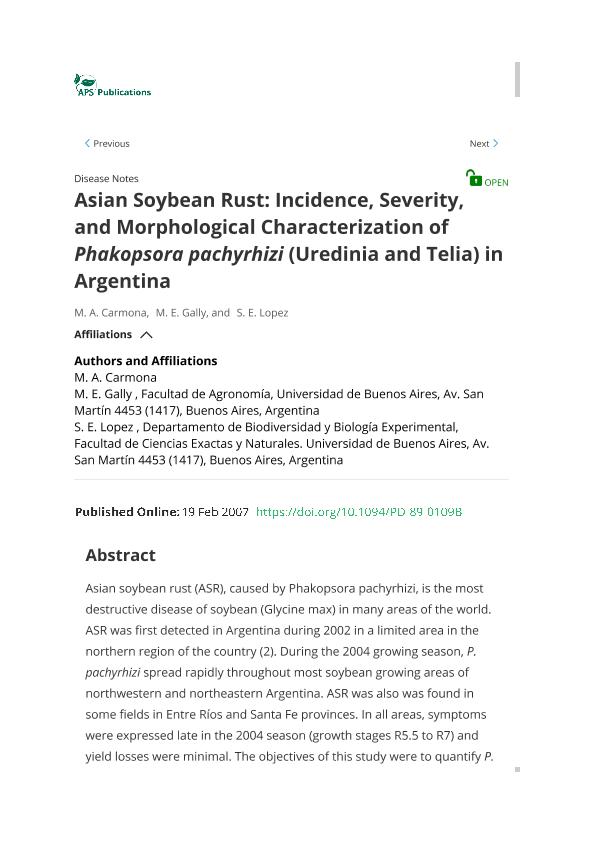Artículo
Asian Soybean Rust: Incidence, Severity, and Morphological Characterization of Phakopsora pachyrhizi (Uredinia and Telia) in Argentina
Fecha de publicación:
12/2005
Editorial:
American Phytopathological Society
Revista:
Plant Disease
ISSN:
0191-2917
e-ISSN:
1943-7692
Idioma:
Inglés
Tipo de recurso:
Artículo publicado
Clasificación temática:
Resumen
Asian soybean rust (ASR), caused by Phakopsora pachyrhizi, is the most destructive disease of soybean (Glycine max) in many areas of the world. ASR was first detected in Argentina during 2002 in a limited area in the northern region of the country (2). During the 2004 growing season, P. pachyrhizi spread rapidly throughout most soybean growing areas of northwestern and northeastern Argentina. ASR was also was found in some fields in Entre Ríos and Santa Fe provinces. In all areas, symptoms were expressed late in the 2004 season (growth stages R5.5 to R7) and yield losses were minimal. The objectives of this study were to quantify P. pachyrhizi infection in the canopy and morphologically characterize the fungus from fields where it had been previously detected by polymerase chain reaction (PCR) (3). Incidence (percentage of plants affected) and severity (percentage of leaf area affected, including chlorosis) were visually estimated for 10 plants arbitrarily collected (April 2004) from each of three fields located in Charata (Chacabuco), Chaco Province (Sample 1, collected in the R6 stage), La Paloma (Moreno), Santiago del Estero Province (Sample 2, stage R6 to R7), and Tolloche (Anta), Salta Province (Sample 3, stage R5.5). Disease assessments were made for the lower, middle, and upper canopy from 15 leaves per plant. The number of pustules per cm2 and uredinia per lesion were recorded from the undersides of central leaflets for each trifoliolate observed. Tissue sections were made to observe fructifications of P. pachyrhizi. Incidence of affected plants was 100% in all fields. Disease severity for Sample 1 was 45% (range 30 to 60%), 20% (10 to 30%), and 10% (5 to 20%) for the lower, middle, and upper canopy, respectively; for Sample 2: 60% (30 to 80%), 40% (25 to 50%), and 25% (15 to 40%) for the lower, middle, and upper canopy, respectively; and for Sample 3: 25% (10 to 50%), 15% (10 to 20%), and 10% (5 to 15%) for the lower, middle, and upper canopy, respectively. The number of pustules per cm2 for Sample 1 was 156/cm2 (range 88 to 200); Sample 2: 172/cm2 (128 to 232); and Sample 3: 120/cm2 (72 to 232). The number of uredinia per lesion for Sample 1 was 6 per lesion (range 1 to 15); Sample 2: 5.5 per lesion (1 to 13), and Sample 3: 2.8 per lesion (1 to 5). The two spore types that were commonly observed were urediniospores and teliospores. Telia were found on infected leaves mixed with uredinia in every sample. Urediniospores measured 16 to 22 μm (mean 18.5 μm) × 25 to 30 μm (mean 27 μm). Teliospores measured 8 to 11 μm (mean 9 μm) × 19 to 27 μm (mean 23.8 μm). Spores sizes are in the range described by Ono et al. (1). To our knowledge, this is the first report of epidemiological and morphological characterization of ASR in Argentina and the first report of the telial stage of P. pachyrhizi on soybean in South America.
Palabras clave:
Soybean Rust
,
Telial Stage
,
First Report
Archivos asociados
Licencia
Identificadores
Colecciones
Articulos(INMIBO (EX - PROPLAME))
Articulos de INSTITUTO DE MICOLOGIA Y BOTANICA
Articulos de INSTITUTO DE MICOLOGIA Y BOTANICA
Citación
Carmona, Marcelo Anibal; Gally, Marcela Edith; Lopez, Silvia Edith; Asian Soybean Rust: Incidence, Severity, and Morphological Characterization of Phakopsora pachyrhizi (Uredinia and Telia) in Argentina; American Phytopathological Society; Plant Disease; 89; 1; 12-2005; 109-109
Compartir
Altmétricas




